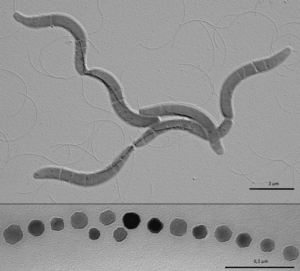Magnetotactic Bacteria
Introduction to Magnetotactic Bacteria

Magnetospirillum gryphiswaldense (also referred to as MSR-1) is a gram negative magnetotactic bacteria that is found in shallow fresh water and sediment. They are characterized by a spirillial morphology with flagella at each end of the cell. They are able to orient themselves based on Earth’s magnetic field (magnetotaxis) due to special organelles called magnetosomes.
Other examples:
Bold
Italic
Subscript: H2O
Superscript: Fe3+
Magnetosome Formation
Include some current research in each topic, with at least one figure showing data.
Genetic Influences
Include some current research in each topic, with at least one figure showing data.
Potential Uses in Bioremediation
Include some current research in each topic, with at least one figure showing data.
Conclusion
Overall paper length should be 3,000 words, with at least 3 figures.
